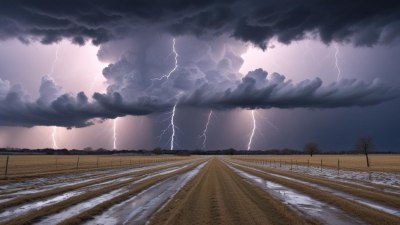Why Outdoor Sports Come With a Built-In Forecast Risk Factor
Explore the inherent risks of outdoor sports and how they relate to weather conditions and projections.

Outdoor sports are immensely popular, drawing millions of participants worldwide. Whether it's skiing down snowy slopes, hiking through scenic trails, or surfing powerful ocean waves, outdoor sports offer thrill and excitement. However, they also come with a built-in forecast risk factor that can significantly affect the experience of athletes and enthusiasts alike. Understanding this risk factor is crucial for everyone involved, from casual participants to seasoned professionals. In this article, we will delve into the various dimensions of outdoor sports and the inherent risks they pose, particularly focusing on the influence of weather and environmental conditions.
The Nature of Outdoor Sports
Outdoor sports inherently involve interacting with unpredictable elements of nature. Unlike indoor sports, where conditions can be controlled—like temperature, light, and surface—outdoor sports are subject to changing weather conditions including sunlight, rain, snow, and wind. Even a slight shift in weather can potentially change the dynamics of the game or sport being played. The unpredictability presents a form of excitement but can simultaneously heighten risk and lead to dangerous situations if precautions aren't taken.
The Role of Weather in Outdoor Sports
Weather is often the most significant factor influencing outdoor sports. For example, a sunny day can offer optimal conditions for a game of golf, while heavy rain can turn the field into a muddy obstacle course. Weather impacts not just the playing conditions but also the participants’ physical and mental performance. Athletes must consider how different environments affect their energy levels, stamina, and strategies. The necessity of monitoring weather forecasts becomes crucial, as athletes need to be prepared for sudden changes that could impact their safety and performance.
Understanding the Risks
The concept of risk is multifaceted in the realm of outdoor sports. Risks can be categorized as environmental, physical, and social. Environmental risks include natural hazards such as extreme temperatures, lightning, or unstable ground. Physical risks encompass injuries that may occur during sports activities, from sprains and fractures to more severe conditions. Social risks can bridge the gap between competition and camaraderie; for instance, aggressive playing styles can increase the chance of injuries amongst competitors. These risks underline the importance of preparation, awareness, and adaptability when engaging in outdoor sports.
Environmental Risks and Forecasting
Environmental risks are largely dictated by weather conditions, making forecasting essential for outdoor sports. Accurate weather predictions can help athletes determine whether it is safe to participate in a sport or if they should postpone the activity. For example, skiers rely heavily on weather forecasts to gauge snow conditions, while surfers track wave patterns and potential storms. The potential for adverse weather conditions can guide athletes toward safer alternatives or methods to gear up appropriately. Understanding microclimates—localized atmospheric zones where weather differs from surrounding areas—can further enhance safety and experience.
Importance of Safety Measures
To mitigate risks associated with outdoor sports, implementing safety measures is vital. These measures may include the use of appropriate gear, such as helmets and pads for action sports or flotation devices for water sports. Additionally, participating in training programs that teach safety protocols and risk assessment can empower athletes to make informed choices. For example, climbers should understand how quickly weather can change in mountainous regions and be prepared with the right equipment and plans in case of emergencies. Safety protocols might also involve understanding evacuation routes, first-aid measures, and communication plans. These become critical in emergency situations where environmental risks turn into real-life threats.
Impact of Technology on Forecasting
Modern technology has revolutionized how athletes prepare for outdoor sports. Improvements in meteorological forecasting through the use of satellite data, computer modeling, and real-time analysis enable athletes to access up-to-date weather information. Apps and platforms designed specifically for outdoor enthusiasts provide live weather updates, alerts, and even forecasts tailored to specific sports. This technological evolution allows individuals to make informed decisions, increasing their safety and enjoyment. Furthermore, wearable technology can now monitor vital signs and environmental conditions, alerting users about extreme changes in weather and advising on optimal activity levels.
The Psychological Aspect of Risk
The psychological aspect of risk plays a substantial role in outdoor sports participation. Many athletes thrive on the adrenaline and exhilaration that come with high-risk sports. This thrill-seeking behavior is often juxtaposed with an inherent understanding of the risks involved. Athletes who engage in these sports frequently learn to develop a heightened sense of awareness, enabling them to anticipate dangers and react effectively. However, the psychological impact of risk can also lead to anxiety and stress, particularly when facing uncertain conditions. Participants must develop coping strategies to navigate these feelings and ensure a balanced experience.
Preparation and Training
The importance of preparation and training in outdoor sports cannot be overstated. Proper training not only enhances skills but also educates athletes about the potential risks associated with various sports. Establishing a foundation of knowledge empowers athletes to recognize hazardous situations and respond appropriately. For instance, trail runners must learn to navigate varying terrain and be aware of changes in weather patterns that can affect their trail. Physical conditioning, along with mental training, can improve resilience against adverse conditions. Physical preparation is accompanied by theoretical knowledge about weather forecasting and environmental hazards, equipping athletes to make well-informed decisions.
Community and Social Responsibility
Outdoor sports foster a sense of community and social responsibility. Engaging with fellow enthusiasts allows for shared experiences, tips on safety, and communal decision-making when it comes to tackling risks associated with weather conditions. Community events, workshops, and discussions often highlight the significance of respecting nature and understanding the risks involved in outdoor activities. Initiatives that promote environmental conservation work in tandem with safeguarding the well-being of participants by emphasizing sustainable practices and risk awareness.
Case Studies and Real-World Examples
Examining case studies can add depth to our understanding of the forecast risk factor in outdoor sports. Events like the 2019 Boston Marathon showcased how weather conditions drastically altered race strategies, showing a correlation between environment and performance. Another notable case is the world of competitive surfing, where professional surfers must contend with unpredictable ocean swells and weather patterns that can dictate their success. Such examples illustrate that athletes across various disciplines must incorporate foresight, strategic planning, and a consideration of weather impacts into their preparations and performance strategies.
Embracing the Risk Factor
The built-in forecast risk factor associated with outdoor sports serves as both a hurdle and a motivator. While risks can pose challenges to athletes, they also contribute to the excitement that characterizes outdoor sports. As participants become better informed about environmental conditions, their ability to manage risks improves, leading to safer and more enjoyable experiences. Encouraging a culture of preparation, respect for nature, and community engagement departs from the notion of risk as a hindrance and propels it into an essential aspect of outdoor sports culture. Embracing risk, while taking appropriate measures to mitigate it, enables athletes and enthusiasts alike to thrive in the natural world, enhancing their connection to both the environment and one another.











